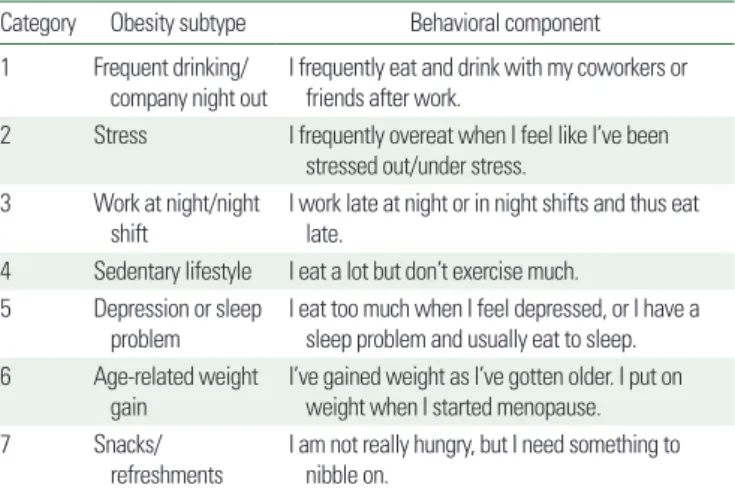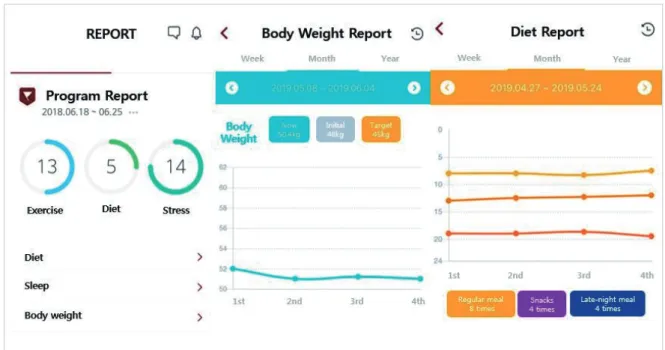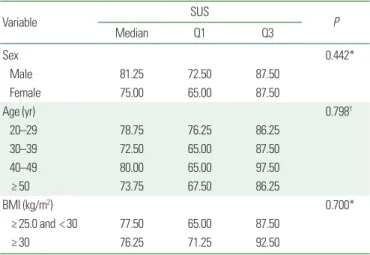Development and Usability of a Life-Logging Behavior Monitoring Application for Obese Patients
Ju Yeon Lee
1, Ju Young Kim
2,*, Seung Ju You
3, You Soo Kim
3, Hye Yeon Koo
4, Jeong Hyun Kim
5, Sohye Kim
6, Jung Ha Park
2, Jong Soo Han
7, Siye Kil
2, Hyerim Kim
2, Ye Seul Yang
1, Kyung Min Lee
11
Department of Family Medicine, Seoul National University Hospital, Seoul;
2Department of Family Medicine, Seoul National University Bundang Hospital, Seongnam;
3YSBio Co., Ltd., Seoul;
4Health Promotion Center, Gachon University Gil Medical Center, Incheon;
5Department of Psychiatry,
6Nutrition Care Services, and
7Health Promotion Center, Seoul National University Bundang Hospital, Seongnam, Korea
Background: Obesity is a global epidemic. Behavior change monitoring using a smartphone application (app) can support weight management in obese patients. These apps must undergo usability testing, which is an im- portant step in mobile healthcare app development. The current study aimed to develop a mobile app for be- havioral monitoring and to test its usability including technical effectiveness, user efficiency, and user satisfac- tion for obese adults.
Methods: Development of the Dr. Youth app components included information on behavioral monitoring in- dicators and their obesity subtypes. The usability of the app was tested with 50 obese adults in a university hos- pital. Participants were asked to complete eight tasks for evaluating the technical effectiveness of the app. The time to complete each task was measured to test user efficiency. To explore user satisfaction, each participant completed the System Usability Scale (SUS). Descriptive statistics were used to examine the mean user efficiency and SUS scores.
Results: Fifty adults (14 men and 36 women, aged 20–59 years) who are obese (body mass index ≥25 kg/m
2) were recruited. The mean age of participants was 42.6 years (standard deviation [SD], 10.8 years); their mean body mass index was 29.6 kg/m
2(SD, 5.7 kg/m
2). The tasks were completed with a 99% success rate. The overall mean SUS score was 76.65 (SD, 15.43).
Conclusion: The Dr. Youth app shows acceptable technical effectiveness, user efficiency, and user satisfaction.
Future study is warranted to establish the app’s clinical efficacy.
Key words: Health behavior, Mobile applications, Obesity, Patient satisfaction
Received June 24, 2019 Reviewed July 23, 2019 Accepted August 30, 2019
* Corresponding author Ju Young Kim
https://orcid.org/0000-0001-6018-3337 Department of Family Medicine, Seoul National University Bundang Hospital, 82 Gumi-ro 173beon-gil, Bundang-gu, Seongnam 13620, Korea
Tel: +82-31-787-7796 Fax: +82-31-787-4078 E-mail: kkamduri@snubh.org
INTRODUCTION
The prevalence of obesity has increased worldwide and is now considered a global epidemic. Globally, the number of obese peo- ple is 650 million
1and the rate of increase of obesity in Korea is similar to the global increase.
2Obesity is an important risk factor for chronic diseases such as arthritis, diabetes, hypertension, dyslip- idemia, cardiovascular disease, and cancer.
3The socioeconomic costs of obesity in Korean adults are substantial.
4In order to con-
trol the socioeconomic burden attributable to obesity, effective strategies for managing obesity should be established and imple- mented.
4Since approaches targeting behavioral changes are important in obesity management, cognitive behavioral interventions, and life- style improvement programs are needed to meet users’ emotional needs. Moreover, a recent study of adult weight management has suggested that mobile health interventions may be effective.
5Be- cause of their widespread use and accessibility, smartphone appli-
Copyright © 2019 Korean Society for the Study of Obesity
This is an Open Access article distributed under the terms of the Creative Commons Attribution Non-Commercial License (http://creativecommons.org/licenses/by-nc/4.0/) which permits unrestricted non-commercial use, distribution, and reproduction in any medium, provided the original work is properly cited.
2017-03-16 https://crossmark-cdn.crossref.org/widget/v2.0/logos/CROSSMARK_Color_square.svg
Development and Usability of a Life-Logging Behavior Monitoring Application for Obese Patients
Ju Yeon Lee
1, Ju Young Kim
2,*, Seung Ju You
3, You Soo Kim
3, Hye Yeon Koo
4, Jeong Hyun Kim
5, Sohye Kim
6, Jung Ha Park
2, Jong Soo Han
7, Siye Kil
2, Hyerim Kim
2, Ye Seul Yang
1, Kyung Min Lee
11



